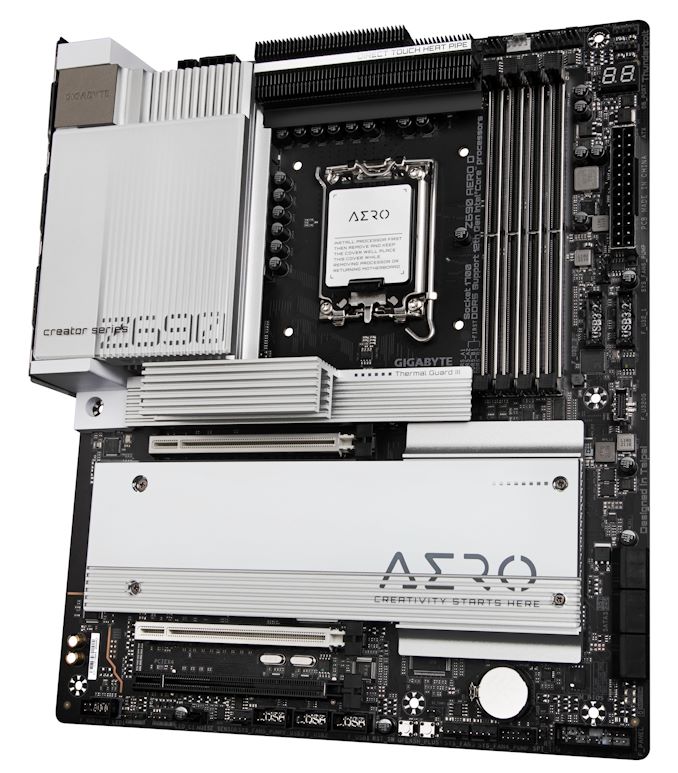The Intel Z690 Motherboard Overview (DDR5): Over 50+ New Models
by Gavin Bonshor on November 9, 2021 9:00 AM ESTGIGABYTE Z690 Aero D (DDR5)
Moving away from the gaming-focused Aorus branded motherboards, and GIGABYTE has announced its content-creator-friendly Aero series will be making a return for Z690. The GIGABYTE Z690 Aero D is a solid representation of this with plenty of premium controllers, high-end features, and good compatibility with external devices. Focusing on the design, the Z690 Aero D is decked out in a contrasting black and silver aesthetic, with a classy large rear panel cover, with silver heatsinks throughout which covers the majority of the PCB. GIGABYTE has also omitted any integrated RGB LED lighting, which is typical of it for its Aero series of motherboards.
Dominating the lower half of the board on the GIGABYTE Z690 Aero D is a pair of full-length PCIe 5.0 slots that can operate at x16 and x8/x8, with a third full-length slot electronically locked down to PCIe 3.0 x4. For M.2 storage, there are four PCIe 4.0 x4 M.2 slots, while only one of these supports SATA-based drives. The Z690 Aero D also includes six SATA ports with support for Intel RAID 0, 1, 5, and 10 arrays. Located in the top right-hand corner is the board's memory slots, with GIGABYTE including four with support for DDR5-6400, and a combined capacity of up to 128 GB.
Looking at the rear panel of the GIGABYTE Z690 Aero D, and this is where all of that content-creator-friendly goodness is. It includes dual Thunderbolt 4 Type-C ports, with six USB 3.2 G2 Type-A ports, and a pair of video ports including one HDMI 2.1 video output and one DisplayPort 1.4 video input. The board's networking configuration is high-end, with an Aquantia AQC107 10 GbE and Intel I225-V 2.5 GbE controller pairing, with an Intel AX210 Wi-Fi 6E CNVi providing both wireless and BT 5.2 connectivity. Integrated audio options are basic, with just two 3.5 mm audio jacks that finish off a premium, yet interesting rear panel layout.












126 Comments
View All Comments
Duwelon - Tuesday, November 9, 2021 - link
Asus' prices are completely bananas. If I build a new rig with Z690 it'll probably be my first non-Asus build in a very long time.Sivar - Tuesday, November 9, 2021 - link
That caught my eye, too. I bought an Asus Hero-branded board for my current system last year at approximately $200 USD.I suspect Asus is shifting their marketspeak because the word "Maximus" (used for the z690 board but not mine) usually applies to their most expensive boards.
blppt - Tuesday, November 9, 2021 - link
This. $2000 for a consumer grade motherboard? WTF are they smoking?Also, I'm pretty sure ASUS will be releasing some TUF Z690s at some point, probably at a lower price point than the primes. My experience with the TUF series has been very positive for the price.
DigitalFreak - Tuesday, November 9, 2021 - link
They know they're not going to sell many of those. Those boards are either for LN2 e-peen competitions or people with more money than sense.Wrs - Wednesday, November 10, 2021 - link
TUF is historically just a bit more expensive than Prime. They already have a TUF DDR4 version - ordered the Wifi one for $290 the other day. If worried about price DDR5 is the first mistake.blppt - Wednesday, November 10, 2021 - link
The X570 TUF was cheaper than the X570 Prime when I went shopping for an AMD board.COtech - Tuesday, November 9, 2021 - link
Subtitle - "Intel Z690 Chipset: Like Z590, But Now With Native PCIe 4.0"I think "But Now With Native PCIe 5.0" is intended.
gavbon - Thursday, November 18, 2021 - link
The Z690 chipset doesn't have PCIe 5.0, this comes from the CPU. The Z690 chipset does, however, now include PCIe 4.0 lanes, whereas Z590 did not.Someguyperson - Tuesday, November 9, 2021 - link
I don't get the "DP IN" ports on the ASUS ProArt Z690 Creator WIFI. I see the author just wrote what was on the ASUS website, but that doesn't really explain anything. Are they passthrough to the Thunderbolt out ports? Is there a capture card built into this motherboard? I'm very confused by the labeling here.uwsalt - Tuesday, November 9, 2021 - link
Those are passthrough to the Thunderbolt port. Add-in Thunderbolt cards work the same way. You slot in your discrete GPU, send the output from both DP ports to the Thunderbolt controller, and then use Thunderbolt to output to a Thunderbolt monitor or hub.